Flaky, buttery croissant bread requires time, precision, and patience, but is a very rewarding baking project that will make your kitchen smell like a French boulangerie. (And is there any better smell than fresh bread?) I know making homemade pastry can seem intimidating, but I thoroughly break down the process for you, step by step, in the tutorial below. Any home baker—like me or you—can accomplish this.
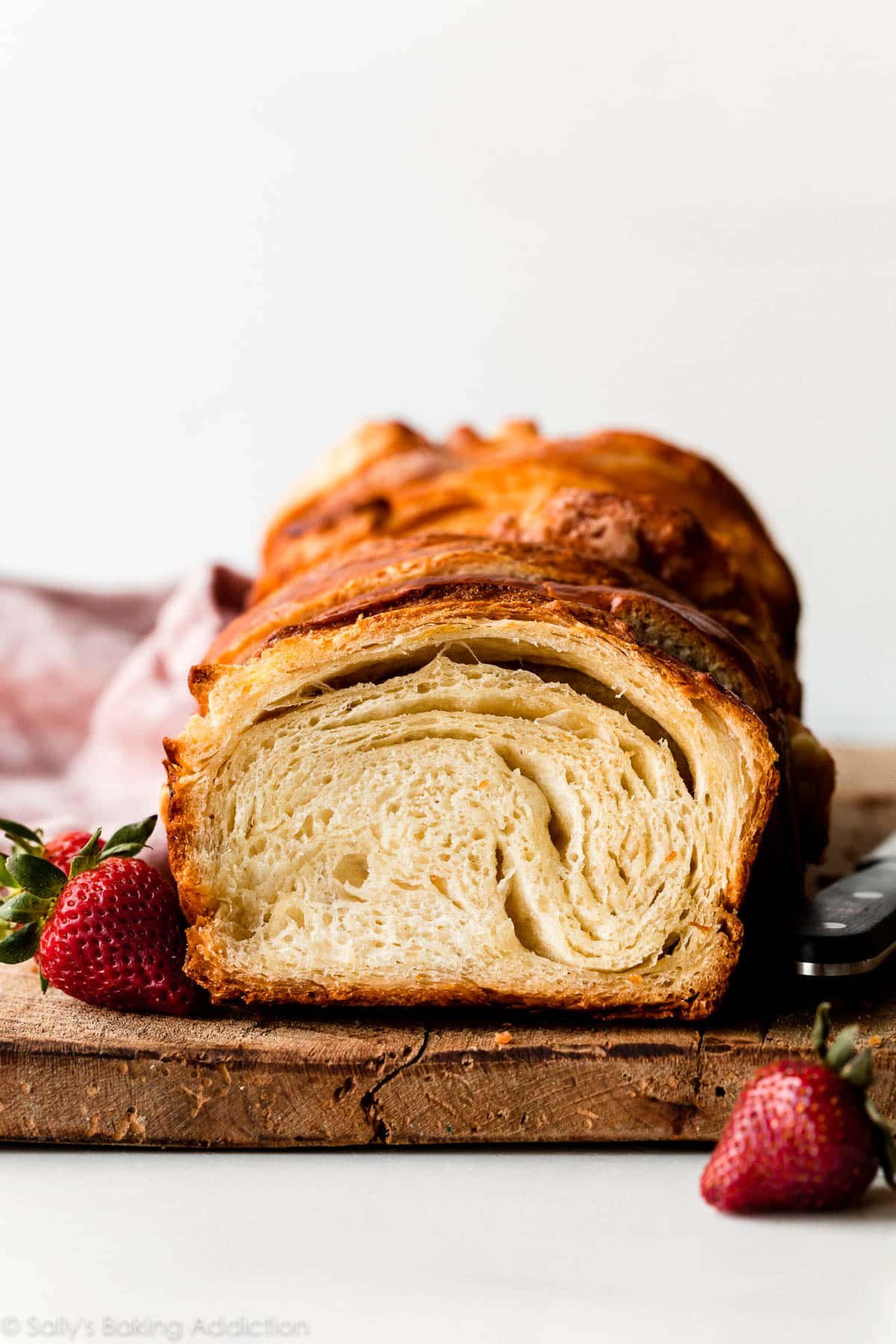
What is Croissant Bread?
Croissant bread is exactly what it sounds like: croissant dough baked as bread. My inspiration for this recipe was this croissant loaf on Food52, but I used a scaled-down version of my own homemade croissants dough to produce just 1 loaf. Though I can’t promise how long your loaf will last… it doesn’t last long in my house! The other difference in my croissant bread recipe is we’re going to roll up the dough first, and then cut into rolls, instead of cutting strips and individually rolling them.
The result is an impressive loaf version of everyone’s favorite yeasted pastry, which smells and tastes like a croissant, but slices like bread. Incredible on its own, but try it as a grilled cheese, BLT, toasted with jam, or in your favorite breakfast strata recipe or French toast casserole!
Croissant Bread Details
- Texture: The texture of this croissant bread is melt-in-your-mouth soft and tender, with a crispy, flaky crust. Because it’s baked as bread in a loaf pan, it’s not quite as layered and crust-shattery (technical terms) as croissants, but it’s still very airy.
- Flavor: Blissfully buttery and slightly sweet—just try to keep your eyes from closing when you taste this, I’m not sure it’s possible!
- Ease: The great news is that making croissant bread is easier than making individual croissants. It requires no special ingredients, but it does require 3 rounds of 20-minute refrigerations and 2 rises. For these reasons, I categorize this as an advanced baking recipe. But I’m here to walk you through each step. You can absolutely make this!
- Time: Plan for this recipe to take just under 6 hours, plus some cooling time, which is considerably shorter than 12+ hours for my individual croissants. There’s resting time between most steps, which means most of the time is hands off. To develop all those flaky pastry layers, croissant dough needs to rest in the refrigerator often. It likes to nap, if you will.
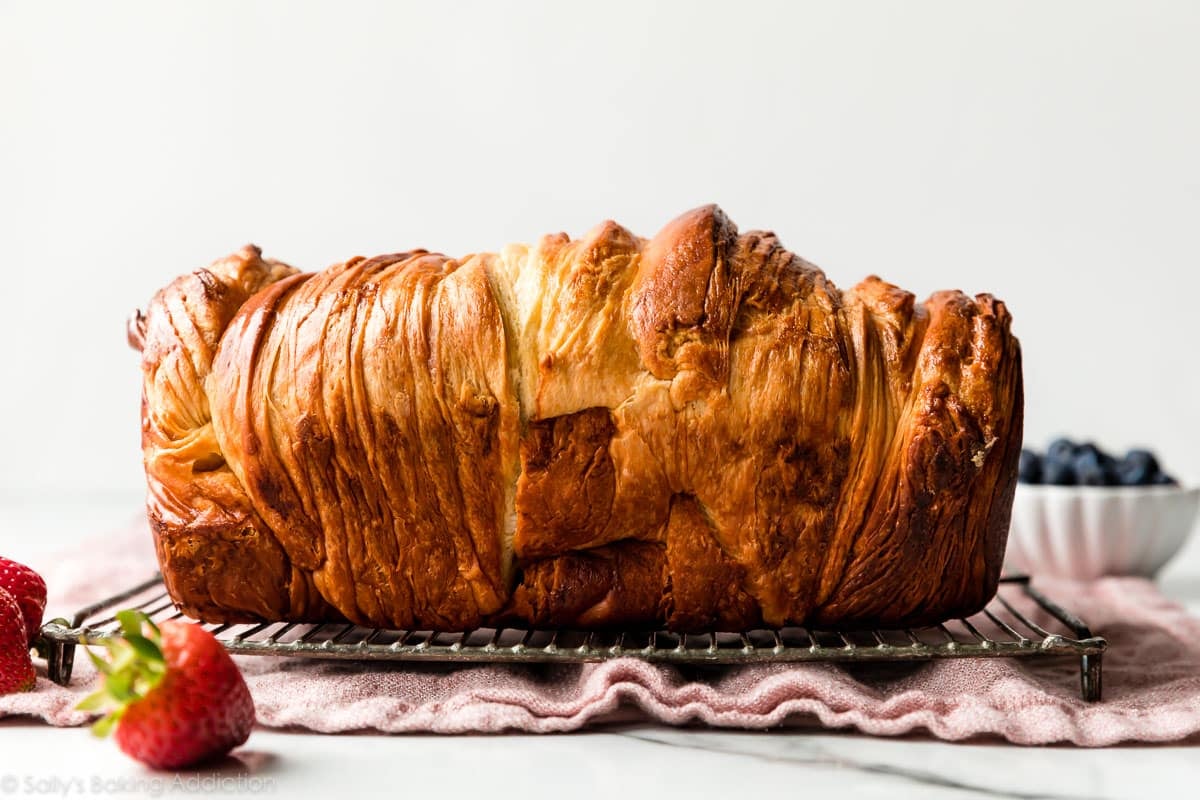
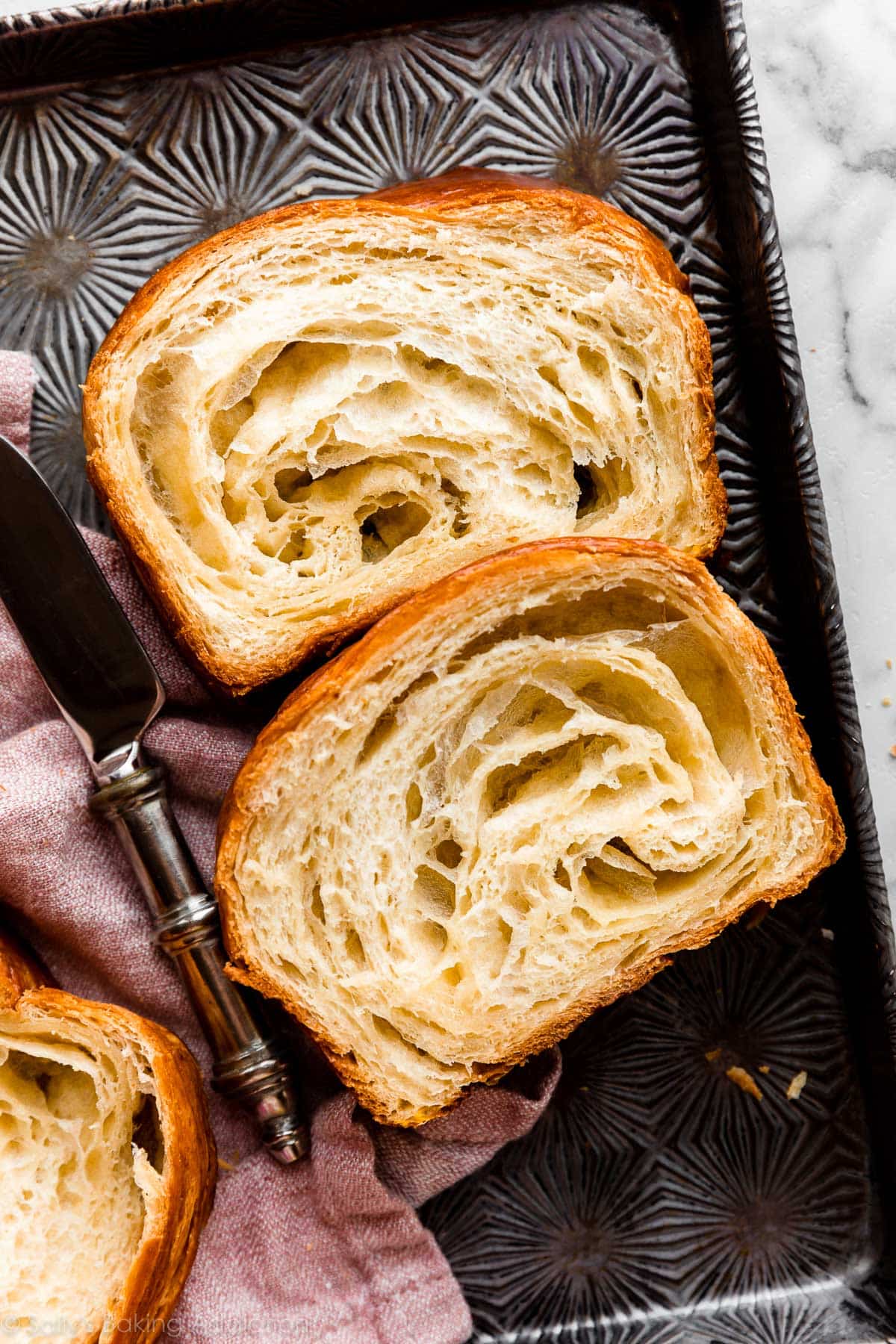
Only 7 Ingredients Total
You need just 6 simple ingredients for the croissant bread dough: flour, butter, salt, yeast, milk, and sugar. The 7th ingredient is an egg to make an egg wash for brushing over the top to get that glossy golden sheen on the top of the loaf—much like pie crust and stromboli.
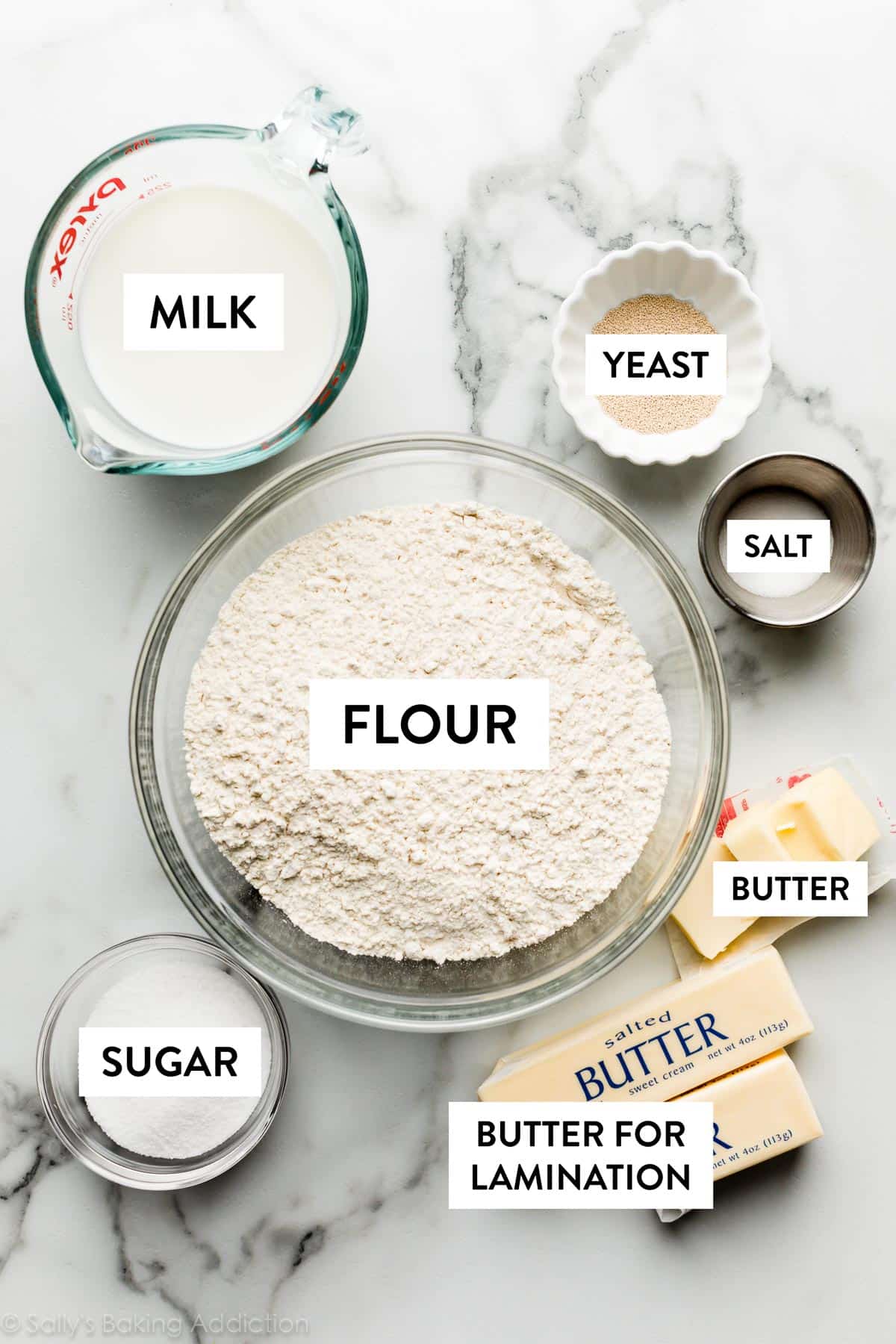
What is Laminated Dough?
Laminating dough is the process of folding butter into dough many times, which creates multiple alternating layers of butter and dough. (Similar to how we make biscuits, cheddar biscuits, and rough puff pastry, though today’s dough includes yeast.) When the laminated dough bakes, the butter melts and creates steam. This steam lifts the layers apart, giving us dozens of flaky, airy, buttery layers.
In my regular croissants and chocolate croissants recipes, we mix butter and flour together to make a butter block. With today’s croissant bread recipe, however, we’re lining pieces of butter down the dough so there’s no compact butter block needed.
4 Tips for Laminating This Dough
- It’s OK if there are air bubbles in the dough; your rolling pin will pop them.
- If the dough tears and butter is exposed, just sprinkle the exposed butter with flour.
- If the dough is impossible to roll, try flipping it over. If it’s still impossible to roll, cover and let it rest for 5 minutes before trying again, to let the gluten relax.
- There are 3 rounds of 20-minute refrigerations. Do NOT extend these times because the yeasted dough will puff up too much. The timer is your friend here!
Video & Photos: How to Make Croissant Bread
The full printable recipe is below, but this recipe involves quite a few steps, so I’m going to walk you through it with step-by-step photos. I’m leaving out photos of preparing the dough because you can see it come together in the video tutorial. I also have a separate video tutorial for How to Knead Dough, if you need extra help with that step.
Here is the dough after the 1st rise and then after you punch it down:
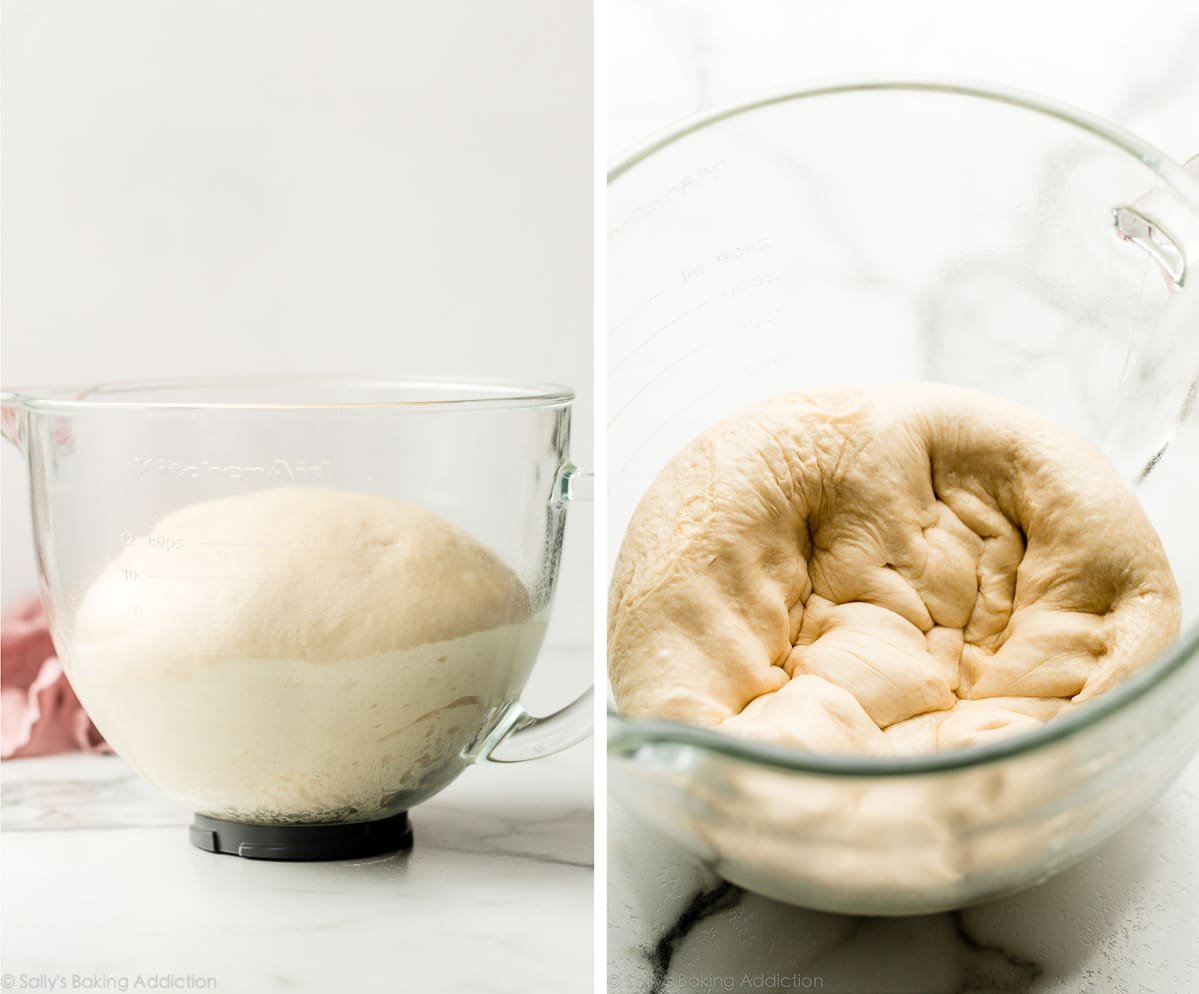
Now it’s time to flatten the dough and prepare it for lamination. Gently flatten the dough out into a 10×14-inch (25x35cm) rectangle using lightly floured hands to carefully stretch the dough. I recommend flattening it right onto a nonstick surface so you can literally pick it all up without the dough losing shape. Refrigerate this flattened dough for 20 minutes:
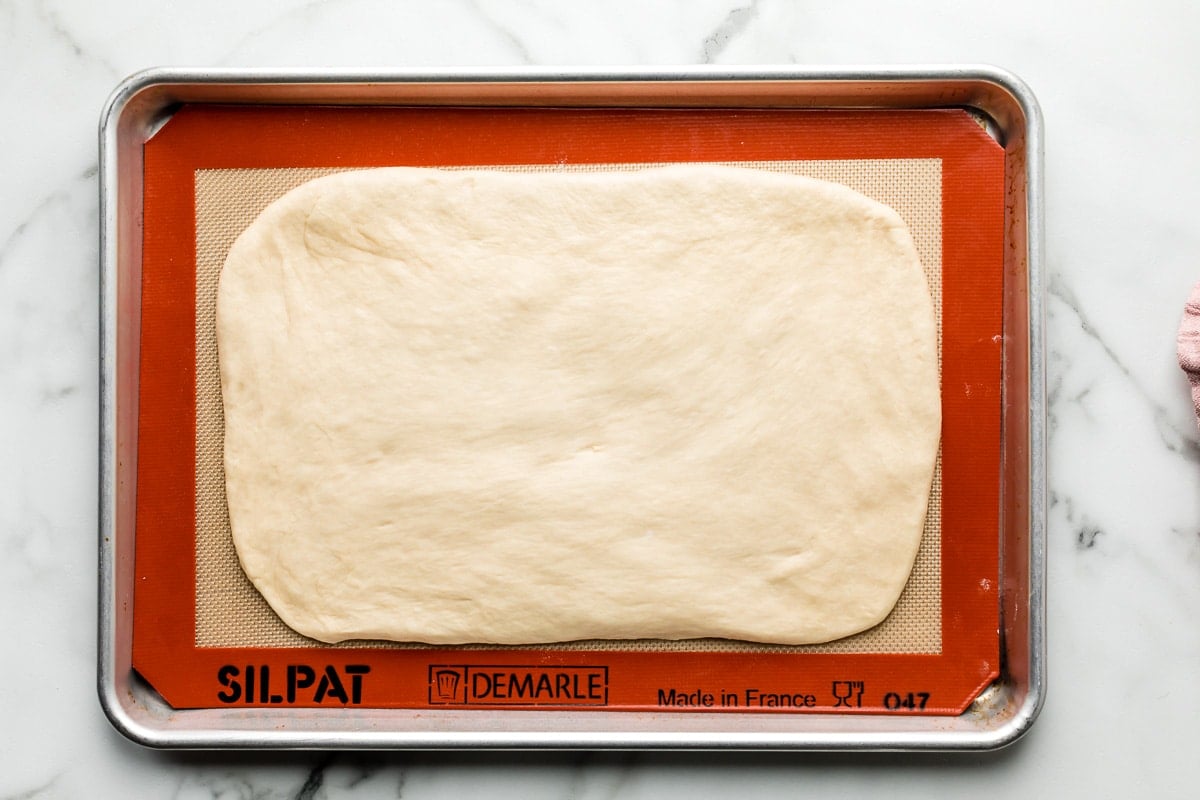
After 20 minutes in the refrigerator, the dough is about as pliable as the butter. Line the butter down the center third of the dough as pictured:
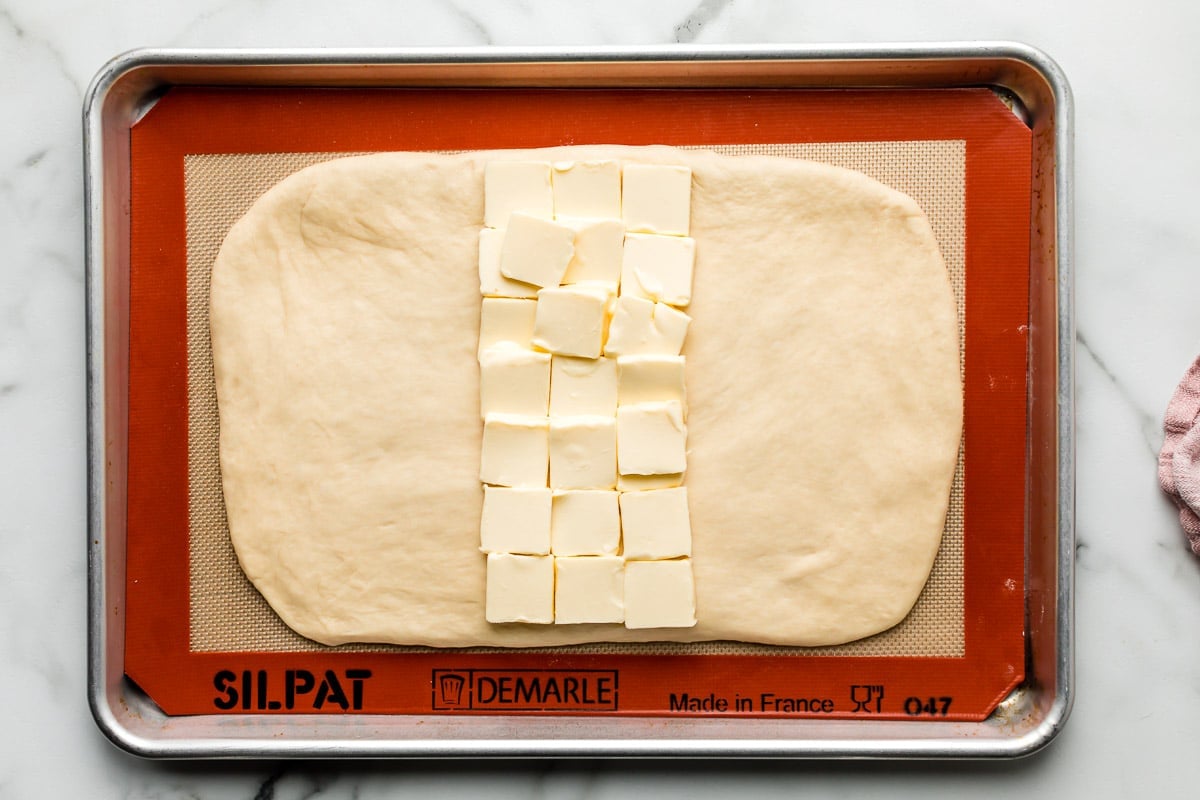
1st lamination: Fold one side over the butter:
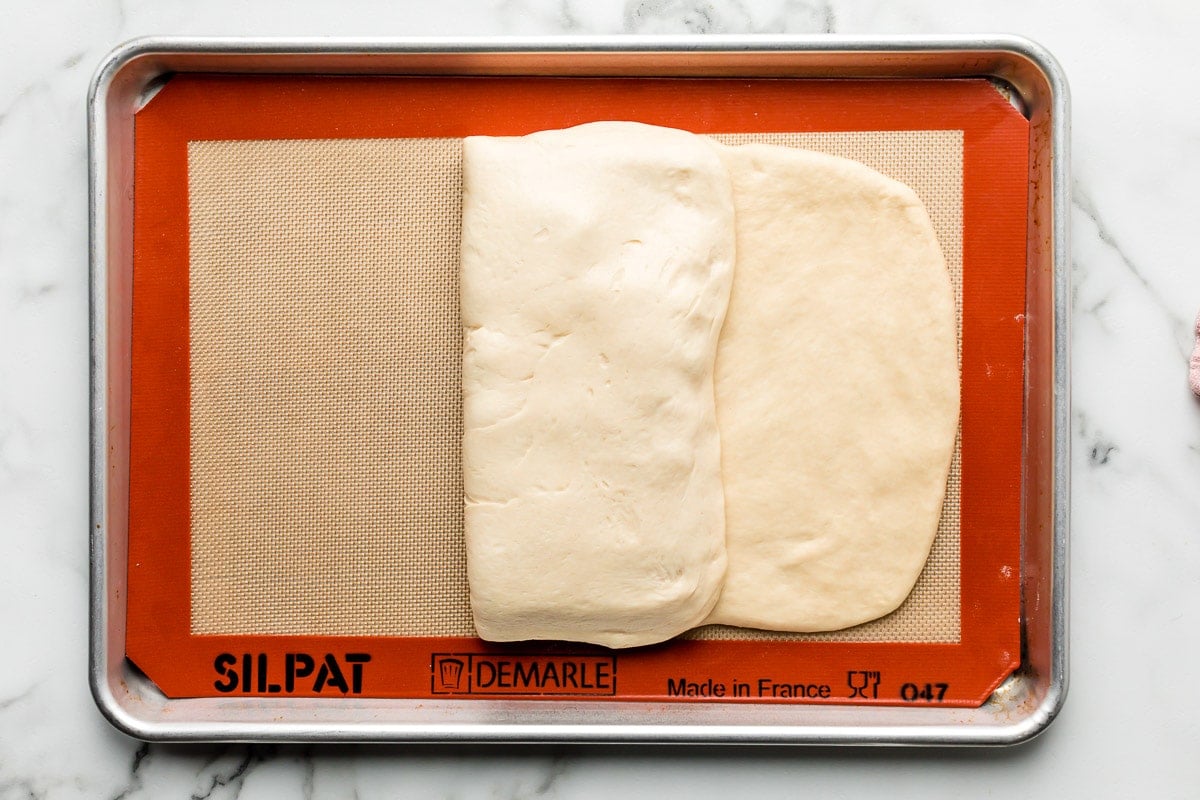
Fold the other side over that, like you would fold a business letter:
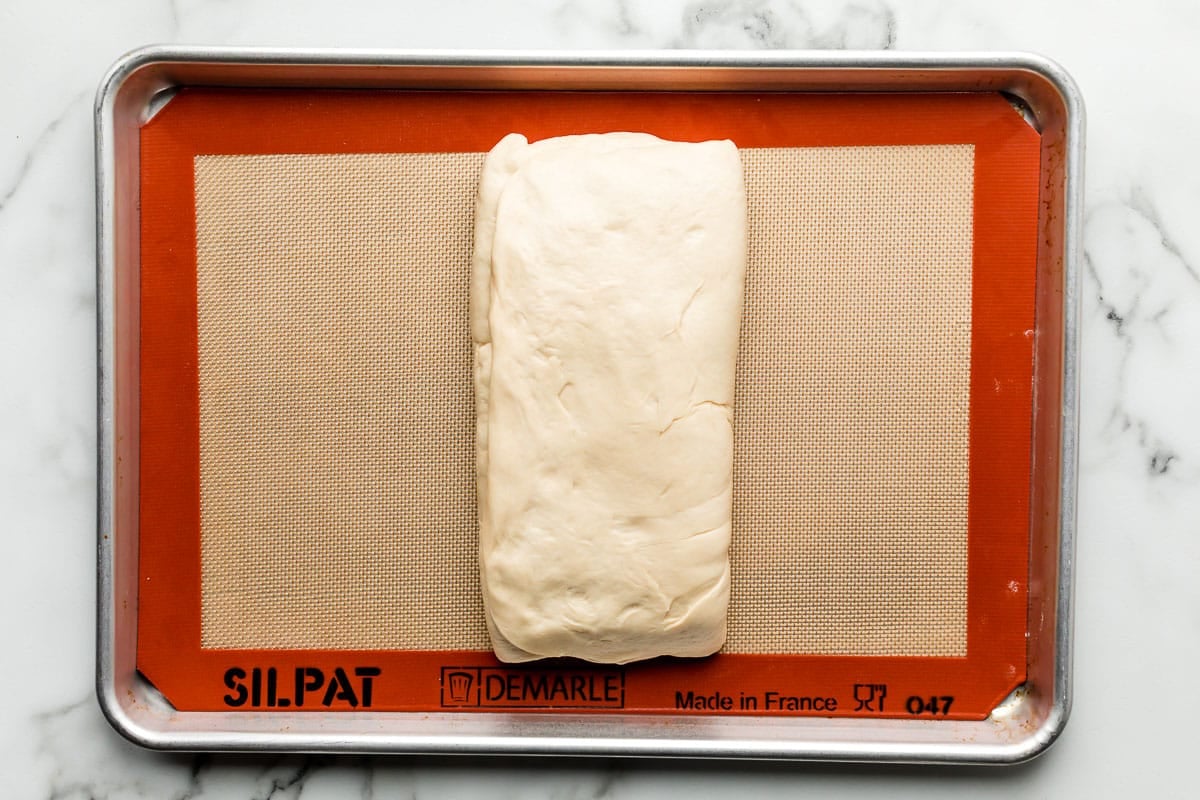
Rotate the dough so the long edge is facing you:
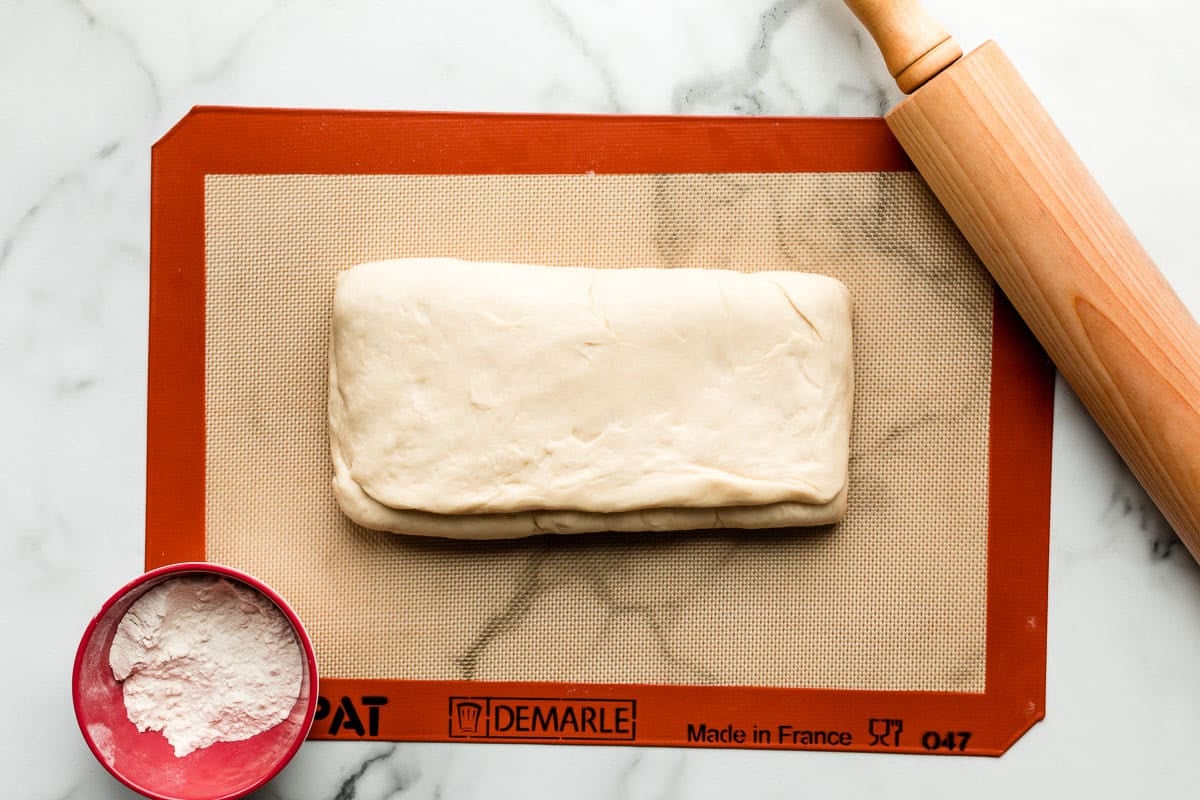
Roll out into a 9×12-inch (23x30cm) rectangle. You can see the butter hiding in there:
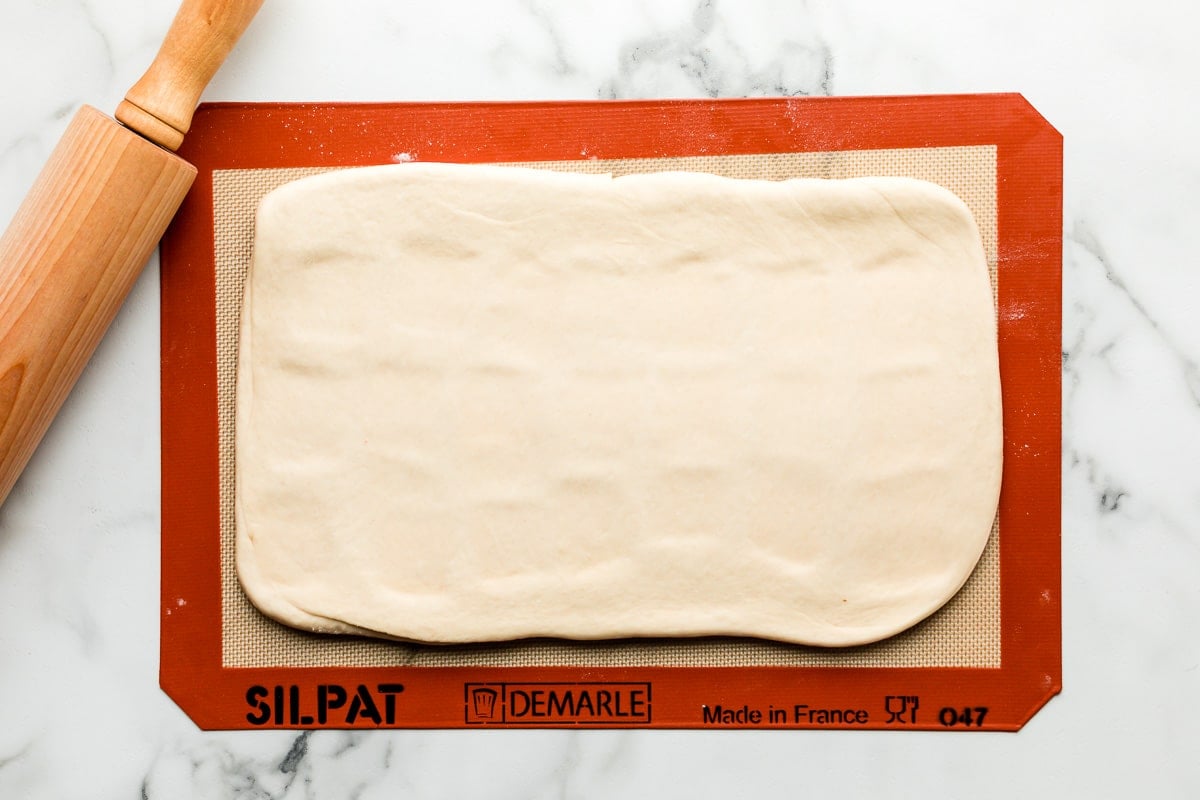
Fold up like a business letter, cover, and then chill for 20 minutes:
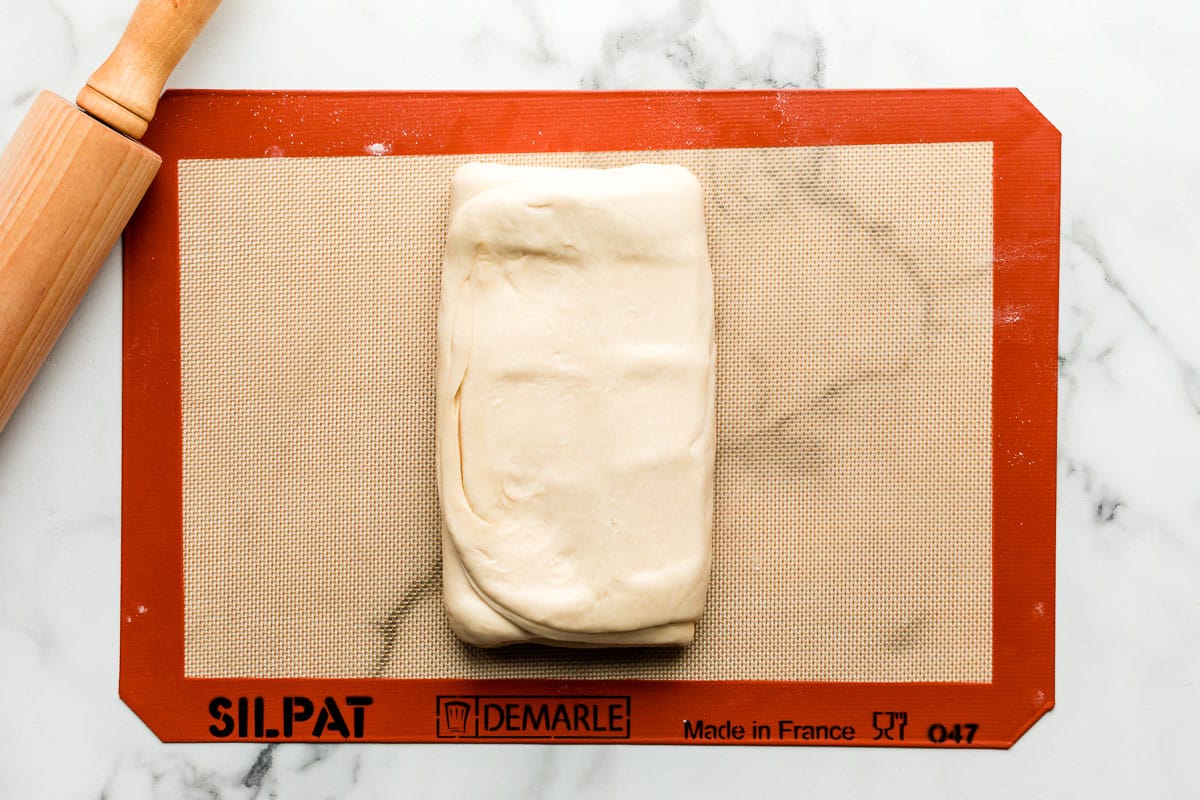
2nd & 3rd lamination: After refrigerating, repeat lamination process above 2x with no dough chilling between each—rotate dough, roll out, fold like business letter, rotate dough, roll out, fold like a business letter. And then chill 1 last time for 20 minutes.
Final lamination: After that final refrigeration, repeat lamination 1x. Then roll out the dough into a 9×12-inch (23x30cm) rectangle for the last time:
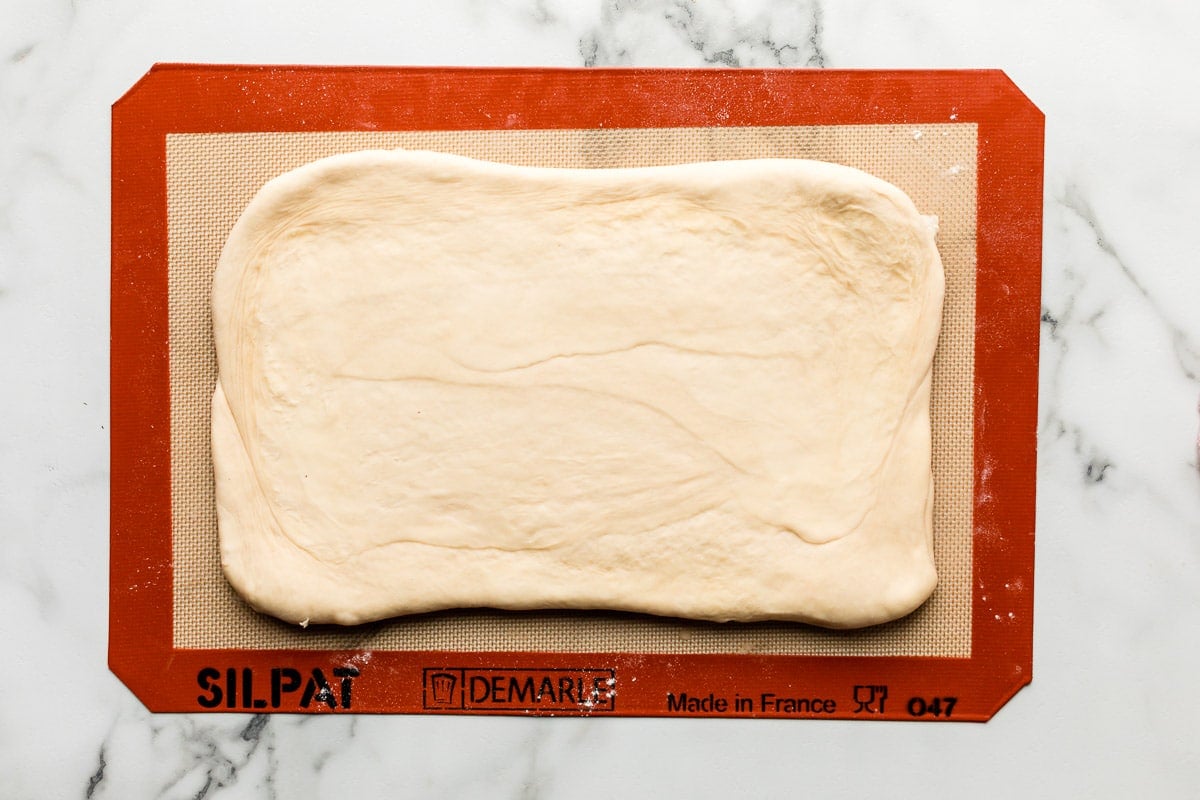
Roll it up like a jelly roll cake or cinnamon rolls dough, starting from the shorter end:
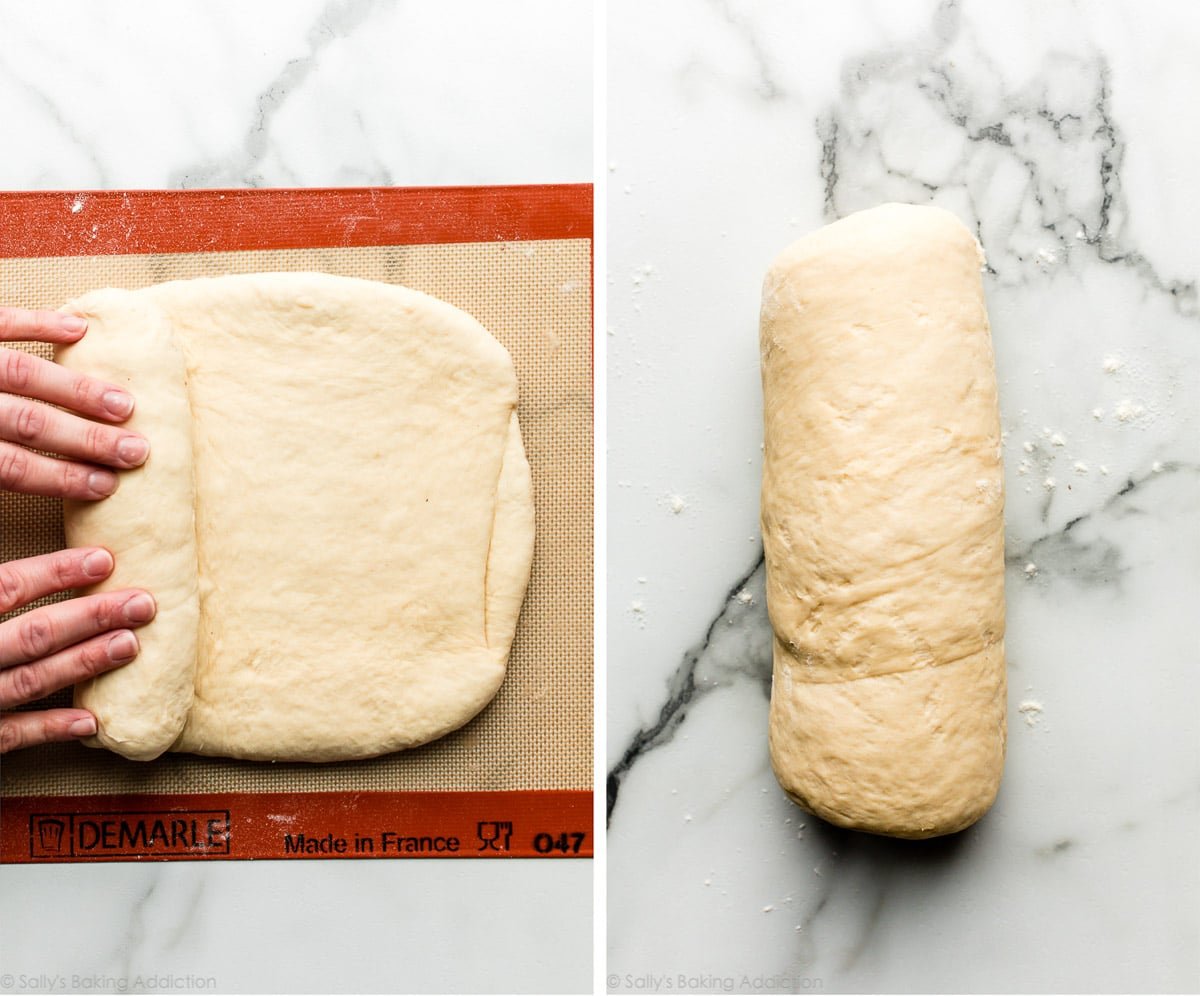
Slice into 5 thick rolls. Look at all those layers!
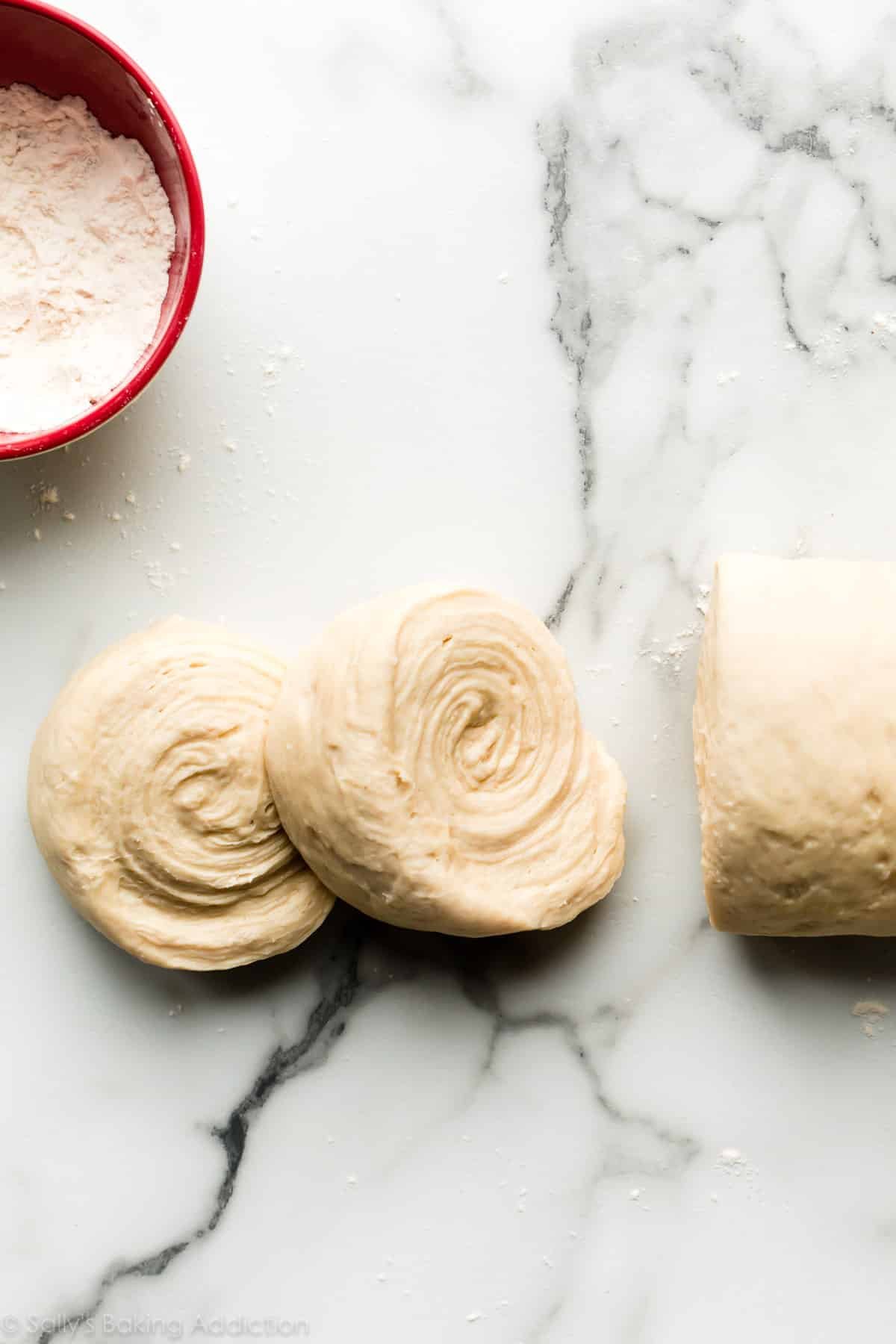
Arrange in a greased loaf pan, cover, and let rise until puffy. Then brush with egg wash before baking:
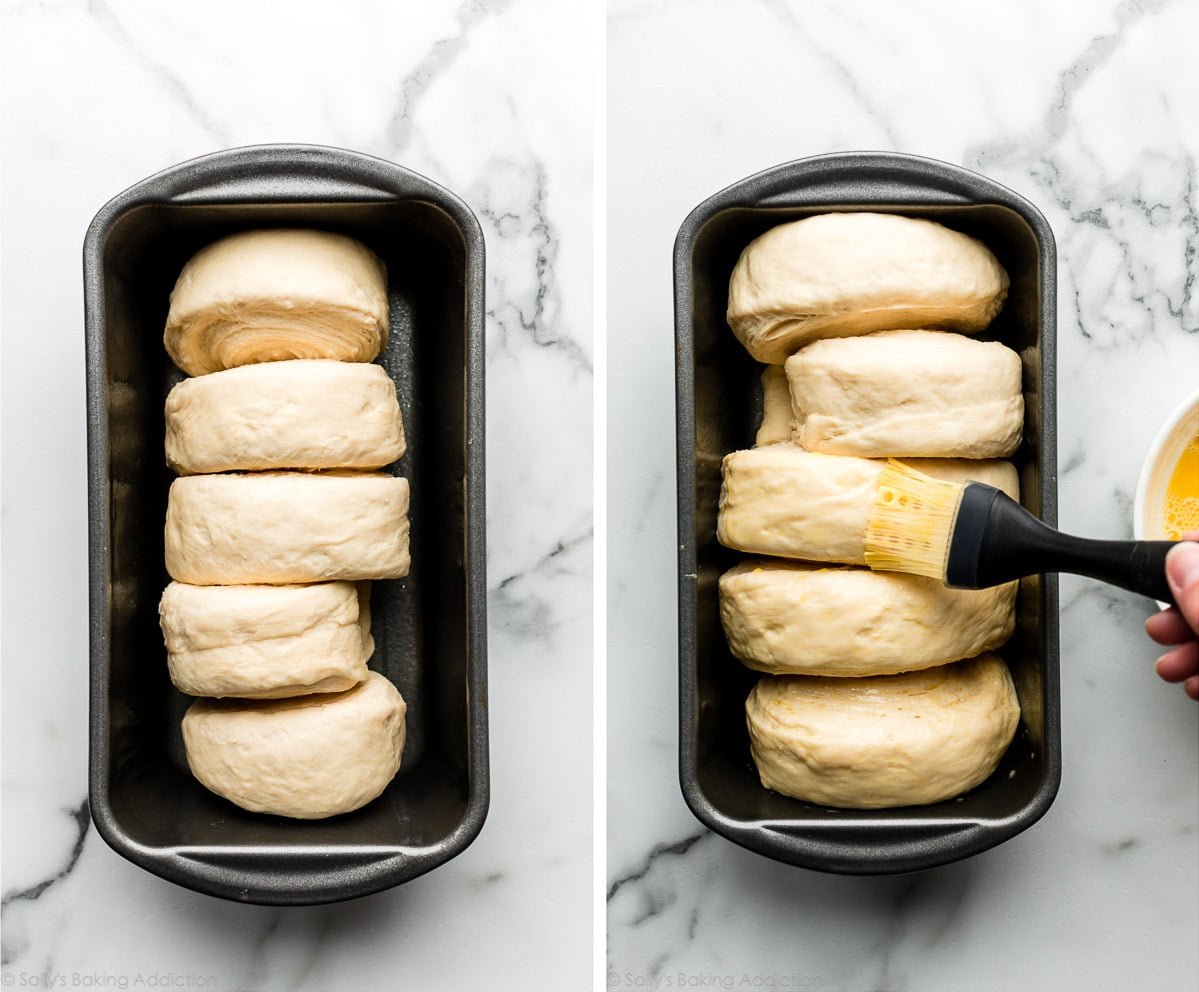
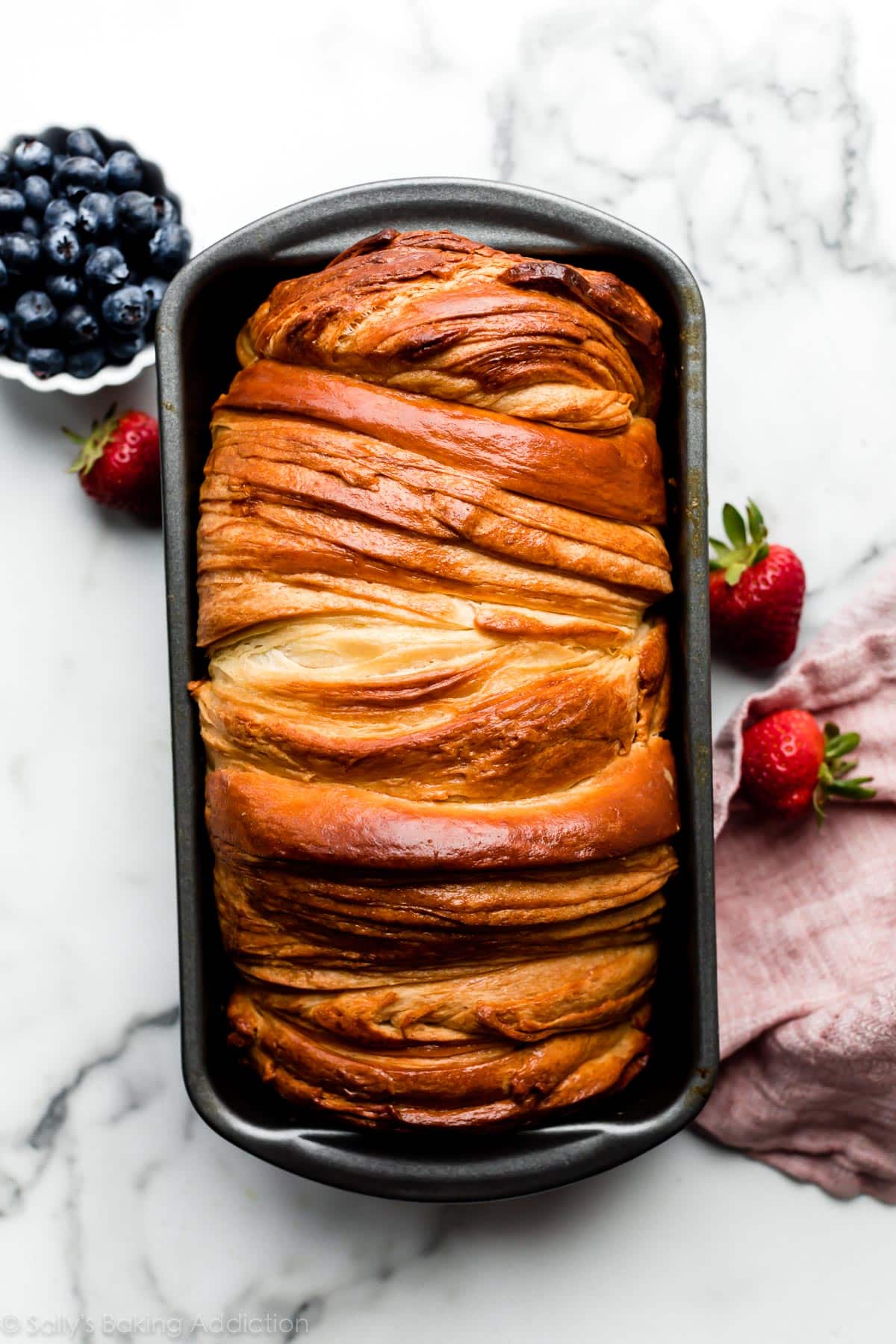

No Two Loaves Look the Same
Keep in mind that your loaf may look exactly like or slightly different from these photos. Despite following the exact same recipe and directions, some of my test loaves looked more airy, or less flaky, or more layered. You can see the variety in these photos. So don’t be discouraged if yours looks different… just wait until you TASTE it!
See Your Croissant Bread!
Feel free to email or share your recipe photos with us on social media. 🙂
Print
Croissant Bread (Loaf)
- Prep Time: 4 hours, 45 minutes
- Cook Time: 1 hour
- Total Time: 6 hours, 30 minutes (includes cooling)
- Yield: 1 loaf
- Category: Bread
- Method: Baking
- Cuisine: French
Description
Bakers of any skill level can use this thoroughly detailed recipe to make a beautifully flaky and golden brown loaf of homemade croissant bread. There are 3 rounds of 20-minute refrigerations. Do not break up the lamination steps and do not extend the refrigeration times because the dough will begin to over-expand.
Ingredients
Dough
- 1 cup (240ml) whole milk, warmed to about 110°F (43°C)
- 2 and 1/4 teaspoons (7g) instant or active dry yeast (1 standard packet, see Notes)
- 3 Tablespoons (38g) granulated sugar
- 1 and 1/4 teaspoons salt
- 3 Tablespoons (43g) unsalted or salted butter, softened to room temperature and cut into 3 equal pieces
- 3 cups (375g) all-purpose flour (spooned & leveled), plus more as needed and for lamination
Lamination
- 3/4 cup (12 Tbsp; 170g) salted butter, slightly softened (see Notes)
Egg Wash
- 1 large egg, cold or room temperature
- 1 Tablespoon (15ml) water
Instructions
- Preliminary notes: Watch the video tutorial and use the step-by-step photos before you begin. Read the recipe instructions and notes before beginning. Make room in the refrigerator for your half baking sheet for steps 6–9.
- Prepare the dough: In a large ungreased mixing bowl, whisk the warm milk, yeast, and sugar together in the bowl of your stand mixer fitted with a dough hook attachment. Cover and allow mixture to sit for about 5 minutes or until foamy on top. *If you do not own a mixer, you can do this in a large mixing bowl and in the next step, mix the dough together with a large wooden spoon/silicone spatula. A hand mixer works, but the sticky dough repeatedly gets stuck in the beaters. Mixing by hand with a wooden spoon or silicone spatula is a better choice.*
- Add the salt, butter, and 2 cups (250g) of flour. Beat on medium speed for 2 minutes, stopping and scraping down the bowl as needed to help the mixture combine. There may still be chunks of butter—that’s ok. Add remaining flour, scrape down the bowl as needed, and beat on low speed until a soft dough forms and pulls away from the sides of the bowl. Dough will be very soft, but not overly sticky. Beat in 2–3 more Tablespoons of flour if dough seems very sticky. Avoid adding more flour than you need.
- Knead the dough: Keep the dough in the mixer and beat for an additional 5 full minutes, or knead by hand on a lightly floured surface for 5 full minutes. (If you’re new to bread-baking, my How to Knead Dough video tutorial can help here.) If the dough becomes too sticky during the kneading process, sprinkle 1 teaspoon of flour at a time on the dough or on the work surface/in the bowl to make a soft, slightly tacky dough. Do not add more flour than you need because you do not want a dry dough. After kneading, the dough should still feel a little soft. Poke it with your finger—if it slowly bounces back, your dough is ready to rise. You can also do a “windowpane test” to see if your dough has been kneaded long enough: tear off a small (roughly golfball-size) piece of dough and gently stretch it out until it’s thin enough for light to pass through it. Hold it up to a window or light. Does light pass through the stretched dough without the dough tearing first? If so, your dough has been kneaded long enough and is ready to rise. If not, keep kneading until it passes the windowpane test.
- 1st rise: Lightly grease a large bowl with oil or use nonstick spray. Place the dough in the bowl, turning it to coat all sides of the dough in the oil. Cover the bowl with aluminum foil, plastic wrap, or a clean kitchen towel. Allow the dough to rise in a relatively warm environment for 1.5–2 hours or until nearly double in size. (For a tiny reduction in rise time, see my answer to Where Should Dough Rise? in my Baking with Yeast Guide.)
- Flatten dough: Punch down the dough to release the air. Place dough on a silicone baking mat-lined, parchment paper-lined, or lightly floured baking sheet. (I highly recommend a silicone baking mat because you can roll the dough out in the next steps directly on top and it won’t slide all over the counter.) Gently flatten the dough out into a 10×14-inch (25x35cm) rectangle using lightly floured hands to carefully stretch, but not tear, the dough. Lightly cover and place the entire baking sheet in the refrigerator, and allow the covered dough to rest and chill for 20 minutes. Do not extend this time.
- Meanwhile, prepare for lamination: Cut the salted butter into 1/4-inch thick slices and, as explained in the recipe note below, make sure the butter is not overly soft. It’s important to note the following 4 tips before you begin laminating in steps 8, 9, & 10: (1) It’s OK if there are air bubbles in the dough because your rolling pin will pop them. (2) If the dough tears and butter is exposed, just sprinkle the exposed butter with flour. (3) If the dough is impossible to roll, try flipping it over. If it’s still impossible to roll, cover and let it rest for 5 minutes before trying again, to let the gluten relax. And (4) Do not extend the refrigeration times, because the folded dough will begin to over-expand.
- 1st lamination: Remove dough from the refrigerator and set baking sheet aside. I like to keep the dough on the silicone baking mat when I’m rolling it because the mat is nonstick. Working with the longer (14-inch) edge in front of you, line butter down the center of the dough, covering the center third of the dough. Fold one dough edge over on top of butter, and fold other edge on top of that (like folding a business letter). Pinch/seal the two short ends to enclose butter inside. Rotate dough so the long edge is horizontally in front of you. Lightly flour the top of the folded dough and, using a lightly floured rolling pin, roll out to a 9×12-inch (23x30cm) rectangle. Fold dough edges over on top like folding a business letter. Cover dough, place back on baking sheet, and refrigerate 20 minutes. Do not extend this time.
- 2nd & 3rd laminations: Remove dough from the refrigerator and set baking sheet aside. Rotate dough so the long edge is horizontally in front of you. Lightly flour the top of the folded dough and, using a lightly floured rolling pin, roll out to a 9×12-inch rectangle. Fold dough edges over on top like folding a business letter. Rotate dough horizontally and repeat rolling out to 9×12 inches and folding like a business letter. Cover dough, place back on baking sheet, and refrigerate 20 minutes. Do not extend this time.
- Final lamination & shaping: Remove dough from the refrigerator and set baking sheet aside. Rotate dough so the long edge is horizontally in front of you. Lightly flour the top of the folded dough and using a lightly floured rolling pin, roll out to a 9×12-inch rectangle. Fold dough edges over on top like folding a business letter. For the last time, rotate horizontally and roll out to 9×12 inches. Working from a 9-inch side, roll dough up like you would roll up a jelly roll cake or cinnamon rolls. Place 9-inch log on a cutting board and cut into 5 even rolls (just eyeball it, they don’t need to be perfectly even).
- 2nd rise: Grease a 9×5-inch (23x13cm) loaf pan. Place rolls, seam side down, in loaf pan. Cover tightly and allow to rise until slightly puffy, about 45–60 minutes.
- Preheat the oven to 350°F (177°C).
- Whisk egg wash ingredients together. Generously brush risen rolls/loaf with egg wash. Bake loaf for 1 hour until golden brown on top, loosely tenting with aluminum foil after 25 minutes to prevent the top from over-browning before the center can cook. For an accurate test of doneness, the bread is done when an instant-read thermometer reads the center of the loaf as 195°F (90°C). (Tip: Keep in mind that the bread will continue to cook for a few minutes as it cools.)
- Remove from the oven and place loaf pan on a wire rack. Cool for 30 minutes in the loaf pan. Run a knife around the edges of the pan to release the bread, and then remove bread from loaf pan and cool at least 15 more minutes directly on a wire rack before slicing and serving. (Bread tends to fall apart when sliced warm.) Bread may slightly deflate as it cools.
- Storing & freezing baked bread: Cover and store leftover croissant bread covered at room temperature for up to 3 days or in the refrigerator for up to 1 week. You can also freeze it for up to 3 months and then thaw on the counter or overnight in the refrigerator. Warm up to your liking.
Notes
- Overnight Dough Instructions: After step 10, cover the shaped rolls in the loaf pan tightly and refrigerate for up to about 15 hours. At least 3 hours before you need the bread the next day, remove from the refrigerator, keep covered, and allow to rise on the counter for about 1–2 hours before baking. Alternatively, you can let the dough have its 1st rise (step 5) in the refrigerator overnight. Cover the dough tightly and place in the refrigerator for up to 12 hours. Remove from the refrigerator and allow the dough to fully rise for 2 more hours. Continue with step 6.
- Freezing Dough Instructions: The best way to successfully freeze and thaw this dough is after step 10. (Freezing/thawing before makes lamination difficult.) Cover and freeze shaped dough loaf (after step 10) for up to 3 months. Thaw in the refrigerator at least 3 hours before you need the bread, remove from the refrigerator, keep covered, and allow to rise on the counter for about 1–2 hours before baking.
- Special Tools (affiliate links): Stand Mixer or Large Mixing Bowl and Wooden Spoon/Silicone Spatula | Ruler or tape measure | Silicone Baking Mat (optional but recommended) | Rolling Pin | 12×17-inch Half Sheet Pan | 9×5-inch Loaf Pan | Pastry Brush | Instant-Read Thermometer | Cooling Rack
- Milk: Whole milk is ideal, but you can swap a lower-fat or non-dairy milk. Avoid nonfat milk.
- Yeast: You can use active dry or instant yeast in this recipe. Follow all of the same instructions. If using active dry yeast, the rise times are usually *slightly* longer, but not much. Reference my Baking with Yeast Guide for answers to common yeast FAQs.
- Butter: You can use either unsalted or salted butter in the dough, but be sure to use salted butter in the lamination step. The butter in the dough can be softened to room temperature, even overly softened is fine. However, the butter for the lamination does require your attention. It’s important to make sure your lamination butter is not too cold/hard and you don’t want it too greasy/soft either, because it needs to be about as pliable as the dough to incorporate into it. Sometimes I use a cooking thermometer just to check what temperature my butter and dough are for the lamination step, and it’s ideal they both register *around* 60°F (15°C). Being about the same temperature helps the butter and the dough laminate easily.
- Can I Halve or Double This Recipe? No. Follow the dough recipe precisely as written. If 1 loaf is too much, freeze any extras. If you want 2 loaves, make the dough 2x separately.
- Can I Add a Filling? I tried jam and cinnamon sugar (1/4 teaspoon cinnamon with 2 Tbsp granulated sugar). The only one that worked fairly well was the cinnamon sugar. Anything wet like jam will create too much moisture and the bottom of the loaf doesn’t bake very well. Plus, you need quite a lot to really taste it, which makes rolling up the dough fairly messy and difficult. You can absolutely try adding something dry like the cinnamon sugar, chopped nuts, or even chocolate chips! Spread a thin layer on the dough before rolling it up into a log in step 10.
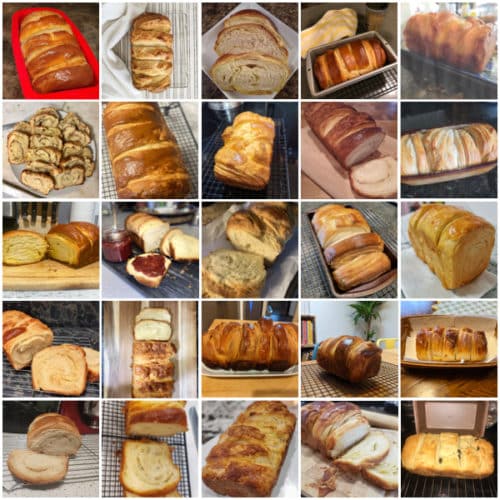
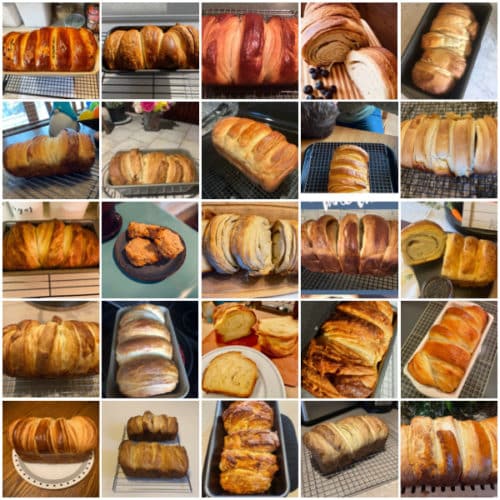
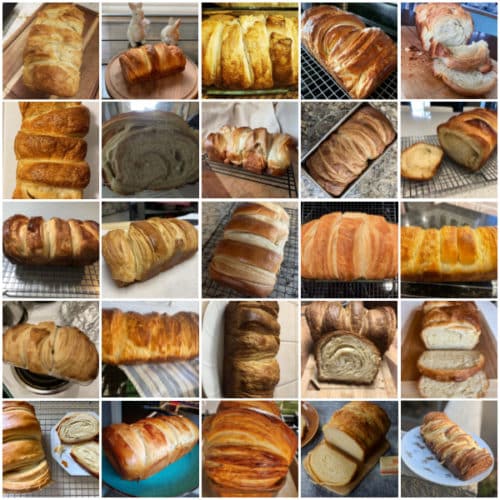
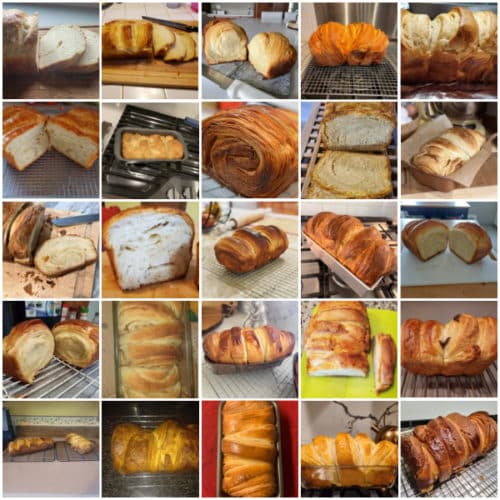
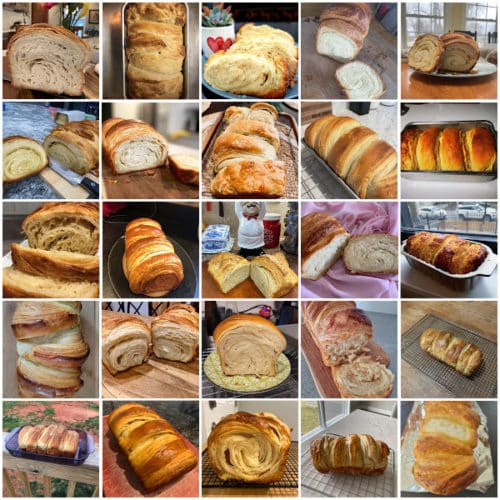
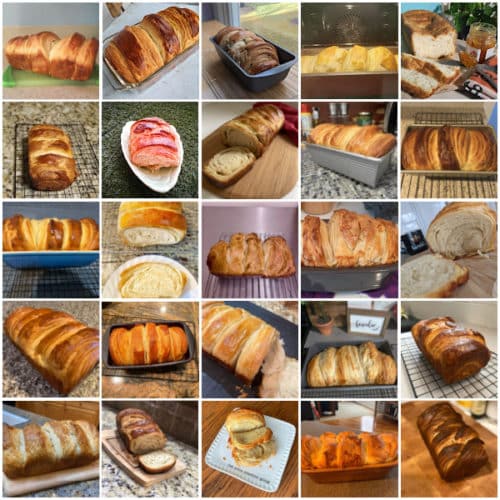
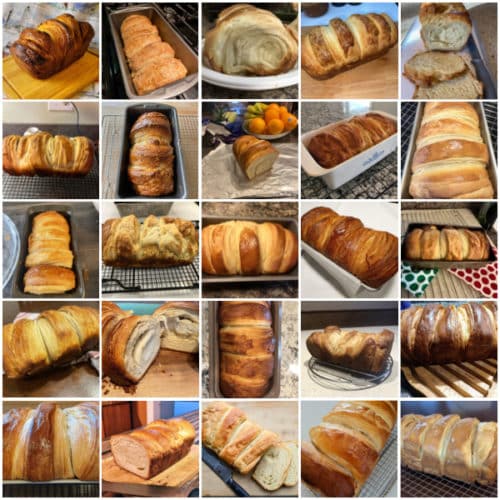

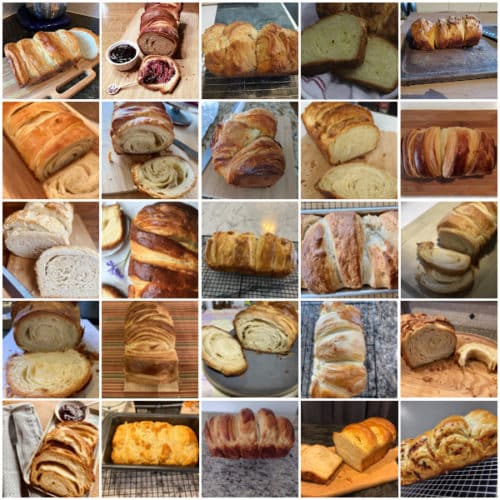
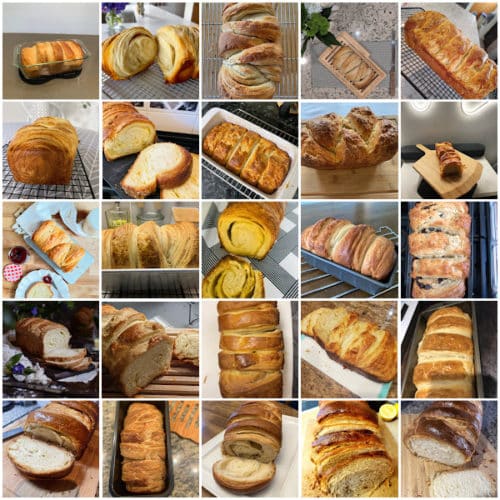
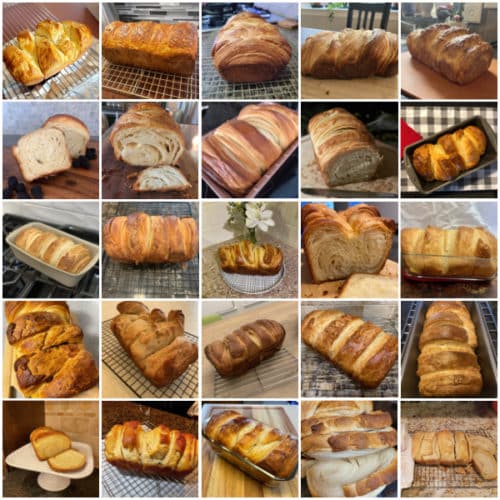

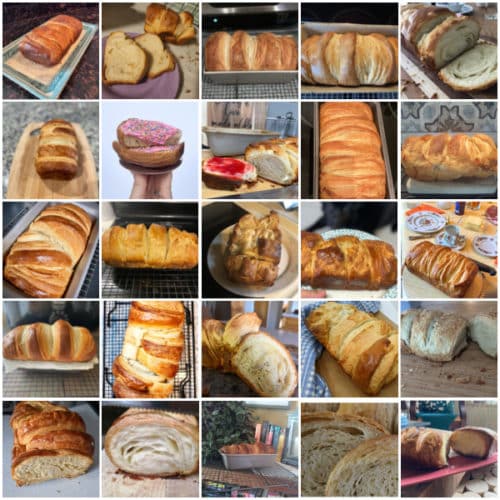
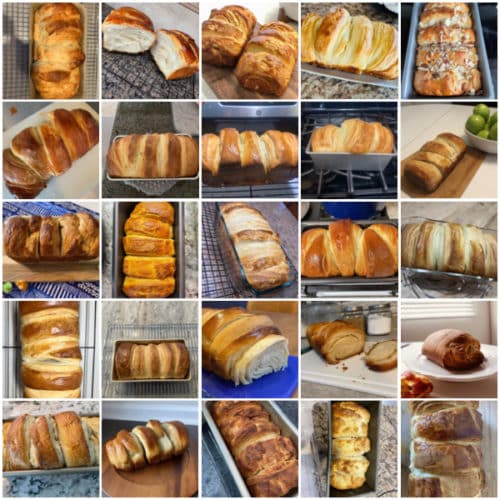
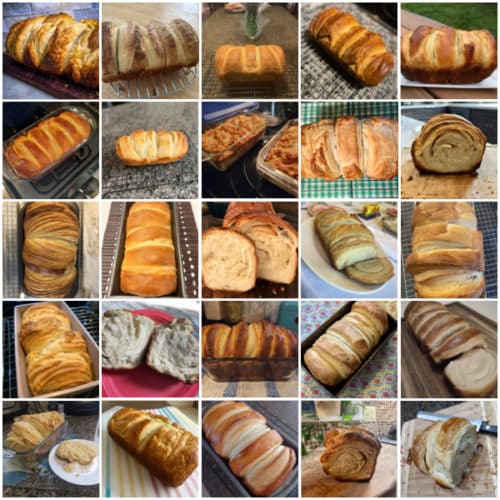
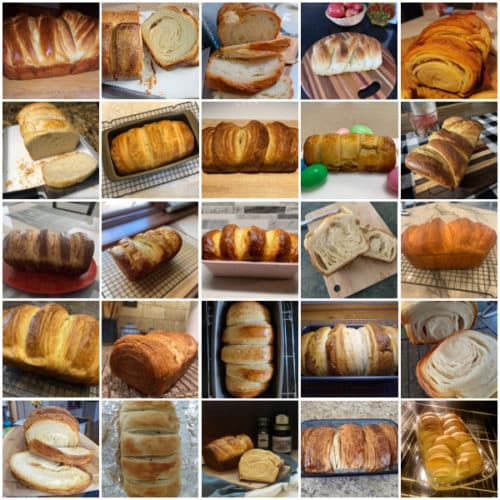
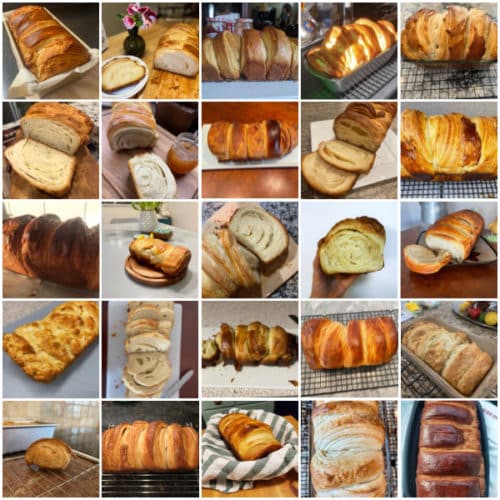
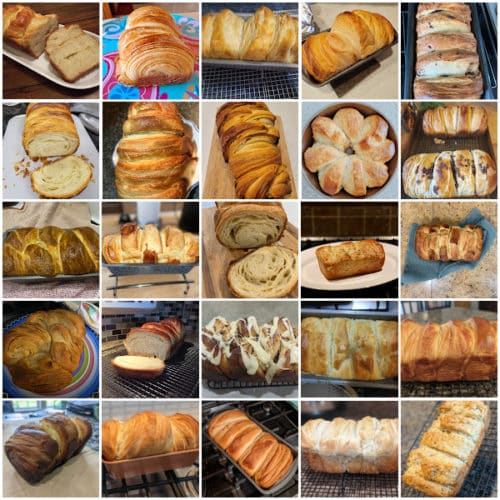
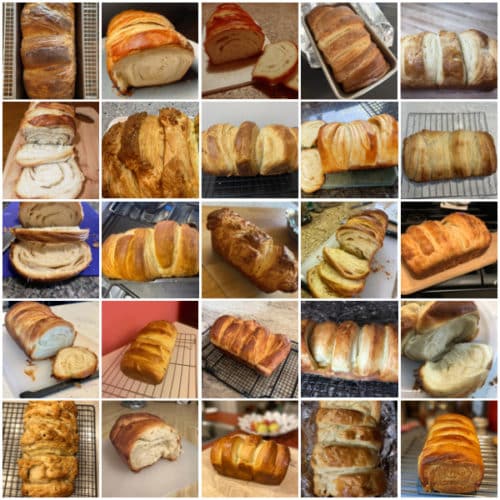
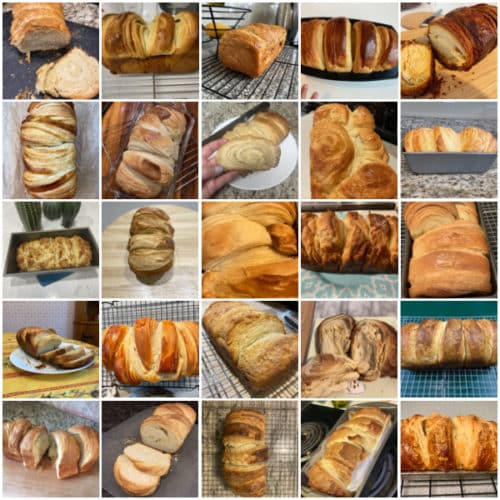
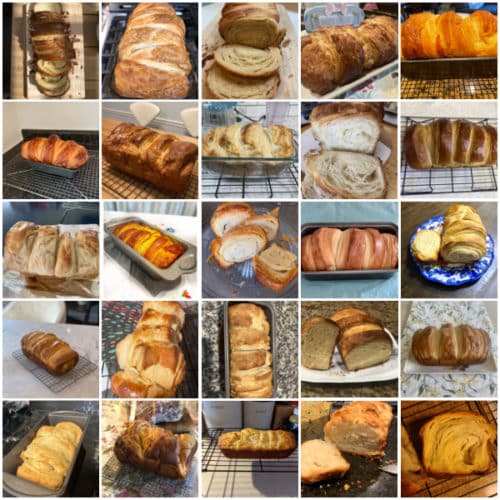
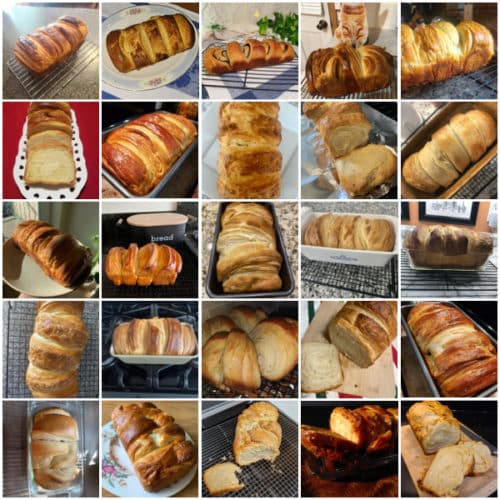
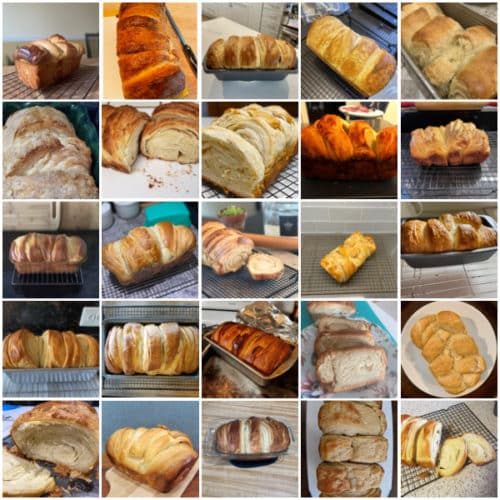
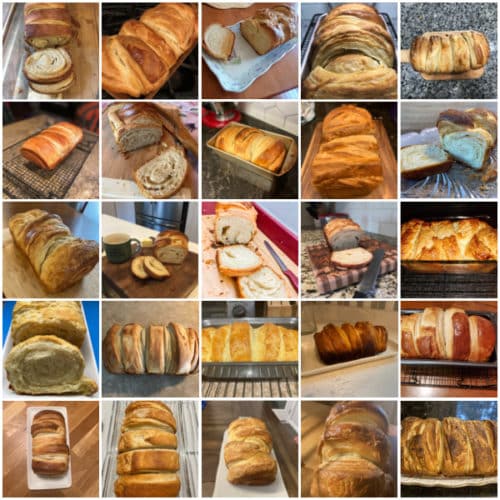
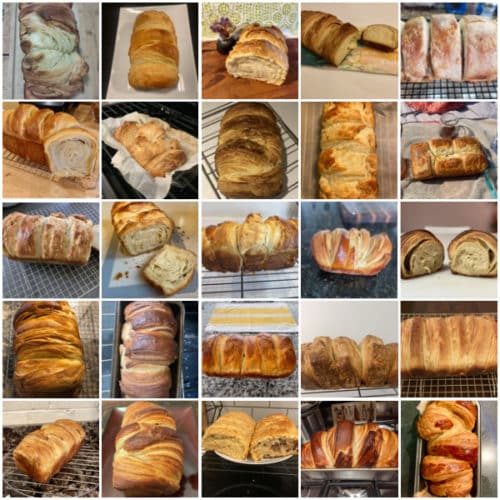
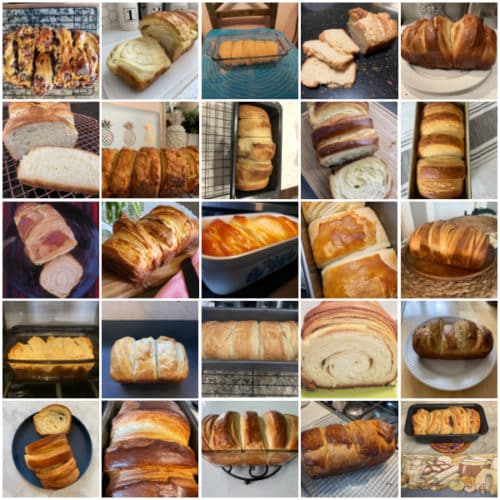

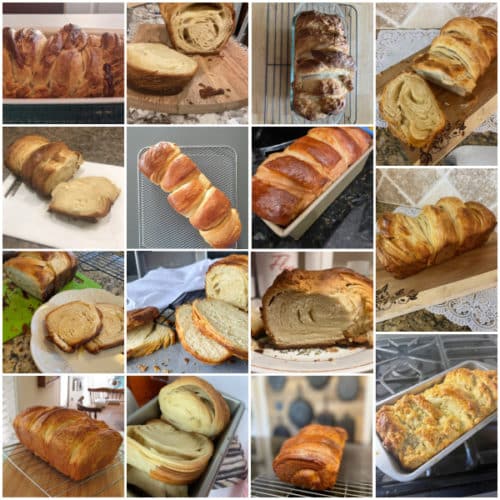



















I really enjoyed making this recipe. It was my first time doing the lamination process. It was less intimidating by the great step by step instructions. Mine came out denser and not as flaky as the photos but it tasted like a croissant. I did follow the instructions on the lamination butter should be 60 degrees and the dough was looking great until the end. During the last steps my dough was greasy. What could be the cause? I definitely want to make it again but would like to know so I can make any corrections. Thank you!
Hi Beth! Was it a particularly warm day or warm in your kitchen? That can cause the butter to melt faster. Try to do the laminating steps quickly to keep the butter from getting too soft. Hope this helps for next time!
This recipe was easy to follow and so tasty! I was thinking about adding cheese before the bake. Do you think that would work? Thank you!!
Hi Shaina, you could try sprinkling the loaf with some cheese before baking. Or, you might enjoy this homemade cheese bread instead!
This was an awesome bread recipe. Sally gave very detailed and video instructions (which I watched while preparing the bread). It turned out perfect, like every recipe from her website. She is Betty Crocker of 2022 but better!! I’m sure Sally had to ask who is Betty Crocker since she is so young. The older ladies will know. ❤️
Hi! Is it possible to use a reduced amount of butter for the lamination (i.e., instead of 1.5 sticks, is it possible to use 1 stick)? If so, what is the recommended adjusted amount?
Hi AW, we don’t recommend reducing the butter for lamination. It plays a key part in creating flaky layers. For best results, we recommend sticking with the recipe as written.
Making this bread was my first time ever baking something requiring lamination and I’m happy with the results! The bread definitely has the taste and softness of a croissant.
This looks delicious! I’ve always wanted to try lamination. I just have a question out of curiosity. What’s the benefit of cutting the final product into 5 pieces vs leaving it in loaf form?
Hi Breann, we cut the 5 pieces so the laminated layers inside aren’t enclosed and can rise up, making the loaf look just as layered as it tastes. And, really, without doing so, the layers inside won’t have as much “breathing room” to expand. You could also cut into 4 or 6 rolls but we found 5 just enough.
THIS BREAD IS EXCELLENT!
Yes, there were many steps, but be patient. The smell while it is baking is heavenly. I swear my mouth must have been drooling while I was waiting for it to cool. First slice..butter and homemade strawberry vanilla bean jam. Making french toast this morning. Thanks Sally for the great recipe and instructions!
SBA is my go-to website for any baking recipe I might need. I was excited to try this one for the challenge, and I was a little intimidated—laminating! Croissants! But Sally is FABULOUS at giving precise and easy-to-follow instructions, so I braved the recipe. WOW! It’s rich, buttery, delicious, and made my house smell like a boulangerie! My loaf is a little dense and not as light and fluffy as a traditional croissant, but I’m fairly inexperienced with laminating. Overall a fantastic and fun recipe to make—I’ll be making it again!
A delightful recipe! I’m so glad you gave us this challenge – I have been meaning to try your croissants but didn’t want too many sitting around to tempt me … somehow a croissant loaf feels much more manageable both in its prep and finish – I made this today, easy to follow the recipe ! Smells so good and we will enjoy it after dinner. I added chopped semi sweet chocolate to part of my log – inspired by your Pain AU Chocolat recipec thank you Sally!
This bread just came out of the oven! So excited to try it.
This recipe has all the things! The finished product is delicious, buttery, flakey and warm. This was the first time I had made a laminated bread dough. It was a challenge, but I felt so successful and delighted when the finished product came out of the oven! I highly recommend this bread loaf.
I felt the exact same way! Very proud of myself and deliciously buttery
This recipe is amazing! The loaf didn’t last long – my family finished it up right away! I’ll definitely be making this croissant bread again!
This recipe was sooo delicious! I love that I got to practice laminating dough; baking it in a loaf pan made the final result a little more forgiving. The bread had a crisp exterior, an airy interior, and a perfectly buttery flavor. Excited to make this again!
I wanted to bring this to a baby shower on a Saturday morning, and wasn’t going to have time to bake immediately ahead of time so I made the dough on the Sunday prior and froze it. I pulled it out of the freezer the night before, and then let it rise for ~ 2 hours on the counter prior to baking. I don’t think it rose enough during that last rise- I think the dough may have still been cold and the pieces stuck together which may have inhibited things. Even though it was maybe a little more dense than intended, it was still delicious and a hit at the baby shower. The lamination steps were very clear and I was surprised that I was able to successfully make this loaf on the first try 🙂
Delicious . Recipe was not difficult and had plenty of wait time. Can’t wait for next month’s challenge.
This was delicious! We tried it with BLTs, but it is so soft and flaky, I think it’s maybe not the best sandwich bread. The croissant loaf is so buttery and tasty, it doesn’t really need topped/filled.
Tastes great and looks attractive! The instructions were very clear. But I did have a dense dough so I started another dough with about half a cup less flour (so used only 2.5 cups). During the last two laminations, the dough and butter became very sticky and started attaching to the rolling pin. My loaf didn’t result in those nice swirls, any advice? Overall a great recipe!
This recipe was so good! It tastes just like croissants, and my son says they’re better than a restaurant! We all loved it!
Delicious… so rich and buttery. It was surprisingly easier to make than I had anticipated!! The hardest part was waiting for it to cool before trying it!! Thank you, Sally, for another wonderful recipe.
This was my first time trying a recipe with lamination and it went so well. There are a lot of steps but it was fairly easy to do. Make sure you cover it like the instructions say because it does brown very fast.
I was intimidated by all the steps and the total time for this recipe but it really was rather easy and just a lot of waiting and repeated rolling. This was a good bread to make as a mom of a toddler as I was able to time the many lamination steps for during nap time and the rest was just waiting for the rises and the bake!
I had a bit of trouble with the dough at first. I used an organic flour and the dough was heavy and not like the dough in the video so I remade it with King Arthur flour and it was perfect. It is a lot of steps but the flavor makes in worth it in the end!
My family really enjoyed this crispy, toasted bread. Thanks for the challenge.
Sally’s recipes are always spot on! If followed correctly you are guaranteed a perfect result.
This recipe requires time and a little extra work but the end result is very satisfying.
Happy Baking!
Delicious bread. Lot of steps but definitely doable. Whole family really enjoyed it.
How can a loaf of bread that is this beautiful and delicious be this easy to make?! Your instructions were clear and concise and made the process fun and easy. I can’t wait to laminate again!
Hi Sally! I don’t have any salted butter for the lamination step. Is unsalted butter ok to use?
Hi Taylor, see note about butter– we strongly recommend salted butter for the lamination. Unsalted butter is fine in the dough.
This recipe was so fun to make! I did it with a friend and we kept texting pictures back and forth. Can’t wait to make again!
I loved the flavor, but it wasn’t as flaky as I had hoped it would be. It was fairly dense. I did have trouble with part of it not rising, but the part that did rise was still rather dense. I may try again to see if I can do better.
This recipe turned out great! It was definitely a bit time consuming, but it was well worth the wait and effort. The instructions were clear and easy to follow, and as such the recipe was not overly difficult. My house smelled amazing as the bread was baking! My bread turned out delicious and so pretty!!